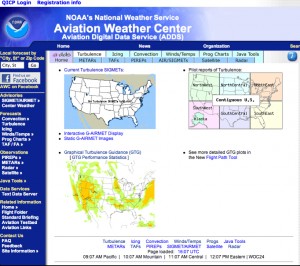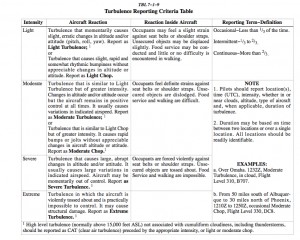The Cleveland skyline glittered, shards of light spraying out upon the lake on this clear and bitterly cold evening. The flight attendant was sleeping in the back of the plane all alone this quiet evening. We had no passengers on this repositioning flight so she was taking a break from the long day. Our groundspeed was over 600 knots as the jetstream pushed us eastward.
Our jovial mood would change shortly as we began to descend into the New York area. The air traffic controller (ATC) informed us the plane ahead of us reported moderate to severe turbulence on the descent into New York. I then turned to the flight attendant and said that she should strap in tight because it might get rough. That was an understatement!
As we descended through twenty thousand feet our tailwind suddenly began to drop. I immediately began to slow to turbulent air penetration speed. A few seconds later we were pressed against our seat belts. My head almost hit the ceiling. The planes pitching and rolling made it difficult to read the instruments.
A few minutes of this turbulence seemed an eternity but as quickly as it came it subsided. I looked at the wind velocity and realized we had lost over 100 knots of tailwind in only a few thousand feet. Talk about wind shear! Luckily someone ahead of us reported the turbulence and the flight attendant was able to buckle up and avoid injury but that is not always the case.
Recently a flight from Tampa to Houston encountered severe turbulence which caused some of the passengers and flight attendants to be taken to the hospital with injuries. I spoke with Fox News Tampa Bay about the dangers of turbulence and the importance of using your seat belt while traveling. The story can be viewed here:
Several injured on flight from Tampa to Houston: MyFoxTAMPABAY.com
A Learning Experience
As pilots what can we learn from this incident and what tools do we have to avoid severe turbulence? We have many resources and general rules of thumb in trying to avoid severe turbulence so lets review.
Turbulence is primarily a hazard to an unsuspecting passenger rather than the airplane. WIth that said severe turbulence can over stress the aircraft if we are flying too fast. So what can we do to avoid turbulence and what do we do if we find ourselves caught in severe turbulence?
Turbulence comes in many forms and is normally a nuisance but if we don't remain vigilant we might get caught in turbulence beyond our capabilities and possibly injure ourselves or others. To avoid this we need to understand a few concepts about turbulence and how to find forecasts and current reports of turbulence.
Causes of Turbulence
The earth's surface varies because the material that covers the surface is not uniform. Grassy fields, black paved roads, and deep blue lakes all absorb and reflect heat differently. Therefore as we fly over one type of land mass to another the air may be rising over a black road while the air is sinking over a deep blue lake. This change in the up and down movement of the air is what causes the day to day turbulence and is normally light.
When the winds begins blowing we may experience mechanical turbulence which is associated with certain man made and natural occurring structures interfering with the winds near the surface. The winds will tend to burble and eddy around these structures and will cause variations in wind and therefore turbulence. If you place a stick in a stream you will see the stick interrupt the smooth flow of water and small ripples will form downstream of the stick. This is an example of mechanical turbulence.
When surface winds are high the resulting mechanical turbulence will also be high causing some wind shear near the surface. Wind shear is any sudden change in direction or speed of the wind. We normally associate wind shear with thunderstorms but if the winds are strong enough we may get wind shear near the surface.
One of the most noticeable causes of turbulence is the movement of air in clouds. These are the most obvious forms of turbulence and can be avoided easily because we can see clouds especially during the day.
Avoiding Severe Turbulence
Thunderstorms and towering cumulus can cause severe to extreme turbulence. These type of clouds especially thunderstorms should be avoided by all and especially smaller aircraft. Smaller aircraft are especially prone to inflight structural damage due to storms.
The updrafts and air flows around these storms can be so strong that they can be felt miles away. The rule of thumb is to stay at least 20 miles from a large thunderstorm. If you are downwind from the storm you want to add more distance since strong winds can blow the turbulent air in your direction. The best course is to fly upwind around any storm while giving yourself 20 miles laterally from the storm.
Aside from avoiding clouds with large vertical development such as thunderstorms we can also choose not to fly during very windy conditions. While close to the ground on a very windy day the mechanical turbulence from terrain and man made structure can disrupt the wind and cause swirling wind currents that can cause severe turbulence.
Another place prepare for turbulence is the boundary layer between two air masses and temperature inversions. A sudden change in wind direction and speed will cause turbulence and on occasion severe turbulence, especially if there is a large wind change across the boundary layer. This sudden change in wind speed is what we experienced the day we flew descended towards New York.
Forecast And Reported Turbulence
Before every flight we must become familiar with all available information including forecasts and reports of turbulence. There are many resources for looking at turbulence both graphical and textual. My favorite resource for turbulence information is the Turbulence page from Aviation Digital Data Service (ADDS) provided by the National Oceanic And Atmospheric Administration's (NOAA).
http://aviationweather.gov/adds/turbulence/
Type and Time
When reading or reporting turbulence you should use the following chart available in the Aviation Information Manual. While you are reading the turbulence report pay attention to two items, the type of aircraft and the time the report was given.
Reports of turbulence are relative. A report of moderate turbulence by a Boeing 747 will likely be severe in a Cessna 172 due to the size difference in the aircraft. The size of a 747 is similar to a large ship sailing through 10 foot seas. The big ship would barely feel the motion of the waves but a small boat would be tossed around.
The time of the report is also important. If a pilot report (PIREP) is old it may help you in discovering a trend in the weather but the more recent reports are what will affect you right now. Also realize the lack of pilot reports is not an indication that there is no turbulence especially if you are one of the first pilots to fly that day. In this instance it is more important to look at the Turbulence forecasts.
Conclusion
It is important to avoid severe turbulence for the safety of our passengers and to avoid damage to our aircraft. Flying around weather that may have the possibility of severe turbulence is much better than actually flying through it instead of wishing you flew around the weather. The more experience you have with reading weather and looking at clouds in the sky the more you will be able to avoid severe turbulence.
I highly recommend your exercising your decision making abilities while on the ground and reading weather forecasts on days you are not flying. Then look for pilot reports throughout the day to see if your estimates were correct. And always remember to report any un forcasts or moderate or greater turbulence to air traffic control or flight service.
Safe flying!
Recommended Reading:



Comments on this entry are closed.
Yes! Finally someone writes about bouncy castle hire.